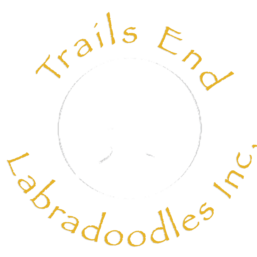PUPPY CARE
WHERE SHOULD MY NEW PUPPY SLEEP?
Your new puppy will feel disoriented in his new home. We provide a handmade blanket with the mom and litter scent. You will want to place this in the crate with him for a few evenings. Limit food and water after 8pm until the puppy is potty trained Also a walk before bed is a great way to get Puppy ready to sleep through the night. Puppy will be looking for reassurance its first night home and we recommend that you let him sleep in the crate in your bedroom near you. This way, you will hear Puppy stir if he needs to go potty during the night. A couple of friendly fingers poked into the crate will be greeted with a thankful puppy kiss at times of insecurity. Gradually, after the first few nights, when your puppy realizes that he has found his permanent and loving home, you will be able to move the crate to another part of the house if you wish. The crate should be just large enough for puppy to lie down and stretch out, but not large enough to walk around in. A crate with a divider that can be adjusted as Puppy grows is best. Puppies dislike soiling or wetting a small sleeping space. Puppy will likely need to go out at least 1 time a night for a while.
WHAT AMOUNT OF REST TIME WILL PUPPY NEED?
Young puppies need a lot of sleep in order to develop healthy emotional and physical systems. LIMIT the playtime with the new puppy, and give Puppy its own chilling out time in his wonderful crate. RESIST the temptation take your new puppy about to introduce him to your friends and neighbors during the first week. Puppy tail may be wagging nonstop, and he may have a great appetite and not appear stressed, but change of home is stress, whether from around the corner or across the world. There will be plenty of time later for showing off your gorgeous new puppy. But in the meantime, be considerate and give Puppy time to find his place in the world, and to bond with you his new pack!
WHEN AND HOW SHOULD I SOCIALIZE MY PUP?
It is a difficult balancing act deciding whether early socialization is worth the risk of contracting disease when a puppy has not finished its course of shots. Early socialization is good, but be guided by your vet and your own common sense. Stay away from dog populated areas, especially where there is or likely has been dog waste. Home Depot and some Target stores are great places to start socialization, but your puppy will be protected best in the shopping cart with a rug or thick blanket on the bottom of the cart. Make sure he is not able to jump out! On beautiful days, we love to take a puppy with us to coffee in an outdoor seating area. People love to stop and visit, which is the whole idea!
YOUR PUPPY’S PLACE
Please remember to puppy-proof the area that the puppy will be in. Limit the puppy territory and extend it as he becomes more trust worthy. The kitchen or the mud room next to the kitchen are great places to start his training in that they are in the family hub where there can be a lot of social contact and also supervision. The puppy should have a quiet place to go when he tired; his crate is best.
CALLING YOUR PUPPY
Try and make a practice to always using their name in a nice tone that they WANT to respond to! Save the growly mad voice for some other words such as bad dog or no. You want them to perk their ears when they hear their name and associate it with good things like belly rubs and treats!
A note about treats most store-bought treats/biscuits are full of preservatives and cheap ingredients that can cause allergies. Petco has freeze dried liver, an excellent choice!
WHEN DO WE START TRAINING?
Early training is a MUST! Your brand new puppy is old enough to learn to sit, down, relax, stay, and so much more. Labradoodles are extremely intelligent! If you are interested in professional train, Trails End clients get 20% off classes at Cooper’s Dog Training in the Tigard/Portland area. Kate is an excellent trainer and has been a speaker at the Northwest Labradoodle Conference. Contact Kate at: (503) 505-9991 www.coopersdogtraining.com.
The most effective training methods use the instincts that your dog is born with to train with. Establishing pack order is very important in a dogs life. YOU are now its pack! Establishing yourself and your family/kids as higher in the pack is not being mean, and your puppy will be happy just to know where he fits in the pack regardless if he is at the bottom of the pecking order or not. Puppy should always be fed last and you and your family eat first. In the wild, the pack leader eats first, followed by the others in order of dominance in the pack. Your puppy needs to know that ALL members of your family outrank it. Therefore, it is a good idea for the children to feed the puppy. Have the puppy sit and stay after he knows the words (see Clicker Training) while his dinner is being prepared. Set his dinner down and click; he just earned his meal.
- PUPPIES AND CHILDREN
Parental supervision is important for good training for the children and the pup! When the puppy has had enough, it time for a nap (you might want one too). It is wise to have children sit down while holding the puppy or playing with the pup until you are confident your child has learned how to handle the pup without injuring him. Should we allow roughhouse playing? Rough and boisterous playing and games such as tug-of-war and chase create bad habits in a young puppy. By all means, the children will want to run and play with their new puppy. But times of quiet play are necessary if the puppy is not to develop into a rough boisterous dog!
- WHAT ABOUT NIPPING AND BITING?
All puppies nip and bite. It is natural. But this should be IMMEDIATELY corrected right from day one. It would not be tolerated in the dog pack, and puppy needs to learn right off that it is LAST in the order of the pack, even down to the tiniest child. When your puppy is mouthing, sharply say ouch! so as to startle puppy so he stops. As soon as he stops, praise him and redirect his attention to a chew toy. We also start teaching our puppies NOT TO JUMP UP by gently pushing their rump down whenever they run or walk up to us. Along with that, we use the clicker training method to teach them sit. To see a U-Tube on clicker training, see our website.
POTTY TRAINING YOUR PUPPY
Nothing new here, its been said by many others, but consistency when doing this stage of training is absolutely important! All babies do best on a routine or schedule Heres a sample schedule for an 8 week old puppy:
Take Pup out first thing when you get up in the morning. Use the same door every time. Always use words that signal what you want him to do: Go Potty When he goes, click and treat. Have breakfast, and feed the puppy.
Puppy goes outside for a potty again after breakfast, gets rewarded, plays for a while (1/2 hour to an hour) and goes in its crate for a nap.
When Puppy wakes up after an hour or two, he goes immediately outside for a potty. Use the Tinkle Bell for MORE EFFECTIVE COMMUNICATION.
Puppy is awake for a while, goes out every half hour for a potty break.
Eat lunch and then feed the puppy.
Puppy goes outside for a potty after a meal, gets rewarded and then goes for a nap in the crate. After he wakes up, he goes outside for a potty break, gets rewarded, and comes back inside to play for a while you get the idea!
You need to be with your puppy and watch him like a hawk the WHOLE time he is with you. To start with, try taking him outside every half hour to go potty, and reward the puppy IMMEDIATELY when he goes potty. Increase the time between potty breaks slowly. We bring the treat out with us so we can give it to the puppy as he is going! After teaching Puppy where you WANT him to Potty, you may want to catch puppy going potty in the house. Sound awful? We keep large washable, rubber backed rugs in our kitchen. This can accelerate potty training if it is handled correctly. Simply say NO! and quickly take Puppy outside (with your treat too!). Don’t forget to praise him profusely when he succeeds! Now he knows where NOT to go and where TO go. Note: Do NOT PUT PUPPY’S NOSE IN HIS OWN MESS. This serves no useful purpose and will only confuse and frighten the puppy.
When you can’t watch puppy like a hawk, he can go in his crate for a short while. Hint: When we are potty training, the new puppy is either in the kitchen with direct supervision, in the crate napping, or tethered right next to Mom or Dad with his toy when 1 of them is working at the desk.
EXERCISE
Labradoodles need moderate exercise, but it is also very important to postpone strenuous, repetitive exercise(high jumps, long runs, high impact wrestling with the big dog next door) until approx 14 months when his growth plates have matured. This is generally true for medium to large dogs especially.
COAT AND GROOMING
The adult Labradoodle coat comes in between 7 to 14 months of age. During this time, his coat will be higher maintenance until the puppy coat comes out and his adult coat comes in. This is a good time to visit the groomer. In fact, if you decide to have your dog professionally groomed on a regular basis, it is a great idea to go when the pup is about 12 weeks old (having been given his 1st 3 sets of shots 1st) for a puppy cut. Often groomers will offer a special price for this time to encourage you to come as a regular customer in the future. Â Your doggie looks so good, and you actually got to go to Starbucks while you were waiting. If you’re a do it your-selfer, check out our homepage for the U-tube on how to groom or go to the ALAA website for their video.
DOG FOOD
We suggest you use FROMM PUPPY and for adults; FROMM ADULT, for a quality dog food (Nature’s Pet Market has it). If you decide to change Puppy’s food, please transition the change over a period of a week. Want to know what dog foods are best? Check out our website home page (dogfoodadvisor).
For more information on how to care for your Puppy: A Slide Show- Click Here.
Blessings from The Rogers at Trails End Labradoodles.

